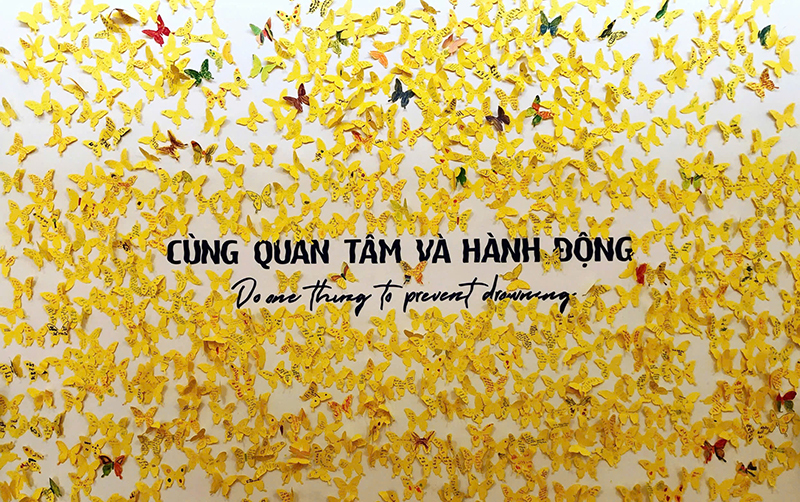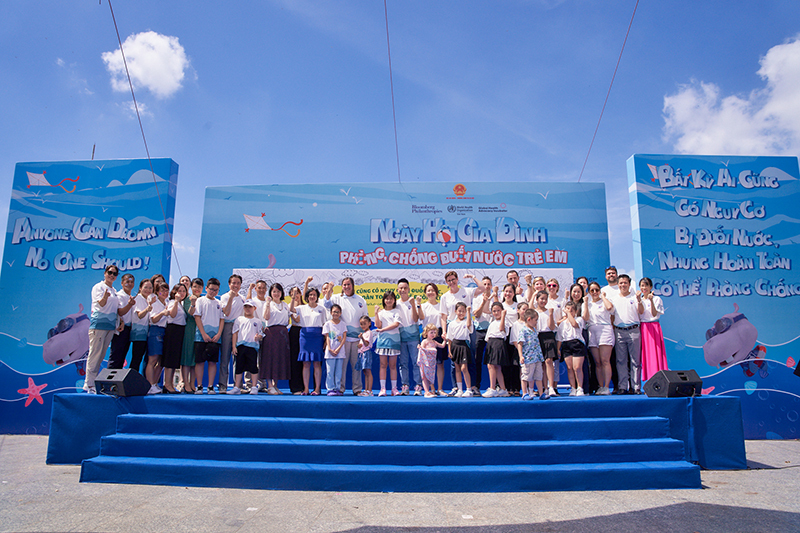In partnership with Vietnam's Department of Child Affairs and World Health Organization, we identified and nurtured policy champions within government structures—influential advocates who amplified our message and sustained momentum for policy development. These champions became force multipliers, translating communication gains into concrete policy outcomes even during periods of reduced external advocacy pressure. We collaborated with government agencies to develop annual communication plans, strategically focusing on peak visibility periods—June (National Action Month for Children) and July (World Drowning Prevention Day)—to maximize impact and maintain sustained policy attention.
How Strategic Communications Is Combating Vietnam's Silent Drowning Epidemic

Between 2018 and 2022, GHAI assisted the government and local partners to orchestrate a transformative, strategic communications campaign that helped to secure landmark national drowning prevention policies that now protect millions of Vietnamese children. Through innovative media partnerships, evidence-based storytelling and multi-level stakeholder engagement, we transformed awareness into action that changed behaviors, supported policy development and created lasting systems for continued impact.
The Challenge
Every year, drowning claims 2,000 young lives in Vietnam—the leading cause of death among children under 15. Yet this preventable tragedy remained largely invisible in public consciousness and absent from policy priorities.
While Vietnam had made remarkable progress in reducing child mortality from infectious diseases, child drowning emerged as the nation's silent killer. Unlike other health crises, drowning remained a "silent epidemic"—widely acknowledged but rarely discussed, and critically, not translated into concrete prevention action.
Our baseline assessment revealed a dangerous paradox: communities recognized drowning risks but lacked practical knowledge about effective prevention strategies. This awareness-action gap was widened by multiple systemic barriers. Traditional awareness campaigns required prohibitive budgets, severely limiting reach and frequency in the highest-risk communities where intervention was most needed. Existing communications failed to address distinct stakeholder needs—policymakers required evidence for budget allocation, parents needed actionable guidance and children needed engaging, age-appropriate content.
While national political will existed, it hadn't translated into concrete provincial action plans or adequate resource allocation, with provincial governments lacking the sustained attention and local advocacy necessary to prioritize drowning prevention. Drowning risks spike seasonally, but communication systems lacked flexibility for precisely timed interventions. Then COVID-19 restrictions fundamentally disrupted traditional outreach methods, demanding rapid pivots to digital platforms.
The mission was clear: transform awareness into action through strategic, evidence-based communication that would change behaviors, support policy development and create lasting systems for continued impact.

Interactive area at the art exhibition on drowning prevention in Ha Noi in 2022
GHAI's Approach
We integrated rigorous data from Hanoi University of Public Health with the lived experiences of affected families, transforming statistics into human narratives. This dual approach proved critical—engaging policymakers who required evidence for resource allocation while connecting emotionally with parents to motivate behavioral change.
Rather than executing isolated campaigns, we cultivated an enduring network of journalist advocates who became partners in our mission. We invited media representatives to every advocacy workshop, established a specialized journalist network focused on child-related topics, and partnered with media monitoring agencies to track coverage. Daily and monthly clippings shared with government partners maintained policymaker awareness and demonstrated sustained public attention. This infrastructure approach ensured drowning prevention remained in public discourse beyond single campaign cycles.
We created a comprehensive ecosystem of touchpoints across all levels:
Nationally, we integrated drowning prevention into broader campaigns—linking it to children's rights during Children Action Month and connecting it to climate change and disaster risk messaging. We leveraged Vietnam's experience with floods to position drowning prevention within familiar disaster preparedness frameworks. Annual World Drowning Prevention Day celebrations featured creative, high-visibility events: art exhibitions, family festivals and dancing and painting contests. At provincial and community levels, we deployed household visits, local television channels and loudspeaker announcements in high-risk areas. Standardized communication packages—infographics, video clips and messaging frameworks—were distributed across program areas through local non-governmental organization partnerships.
Recognizing the power and cost-efficiency of digital platforms, we pioneered creative content that captured attention and facilitated message retention: "Bobo the Hippo," a child-friendly mascot; "I Like to Swim," a catchy original song promoting safe swimming; cartoon animations and short-form video content optimized for social media; and TikTok campaigns meeting young parents in their digital spaces. This digital-first strategy proved especially critical during COVID-19, enabling continued engagement when in-person activities were restricted. We produced live talk shows broadcast during lockdowns and proactively partnered with key government agencies to develop e-posters guiding families on home drowning prevention and conducting survival swimming lessons with social distancing protocols.
We partnered with Hanoi University of Public Health (HUPH) and CommSights as to conduct media monitoring and measure campaign effectiveness, ensuring credible assessment and enabling continuous improvement based on evidence rather than assumptions. Reports were systematically shared with relevant government agencies, informing customized messaging and strategic communication planning for maximum impact.
Results

A wall of messages at the art exhibition on drowning prevention in Ha Noi in 2022.
The campaign didn't just raise awareness—it fundamentally shifted behaviors, supported policy development and built sustainable advocacy infrastructure that continues saving lives.
Perhaps more significantly, the percentage of parents willing to pay for survival swimming classes increased by 44%—an eightfold increase from pre-project baselines. This revealed that families fundamentally conceived drowning prevention as a priority worthy of financial investment.
Strategic communication helped to successfully translate political will into concrete policy frameworks: the 10-Year Inter-Ministerial Action Plan on Child Drowning Prevention established comprehensive, coordinated approaches across government agencies, while the National Program on Strengthening Child Drowning Prevention in the Educational System (2025–2035) integrated water safety into school curricula, institutionalizing prevention for future generations.
The campaign's most enduring impact is the infrastructure it created: a network of journalist advocates continuing to amplify messages; policy champions within government sustaining momentum; media monitoring systems creating ongoing feedback loops; and standardized communication tools that local organizations continue utilizing. This infrastructure ensures impact extends far beyond GHAI's direct involvement.

A ceremony at the family festival on drowning prevention in Ha Noi in 2023.
Lessons Learned
Tailor Communication to Diverse Stakeholders
Effective communication requires distinct strategies for different audiences. Policymakers need evidence-based arguments for budget allocation. Parents need actionable guidance they can immediately implement. Children need engaging, age-appropriate content. One-size-fits-all messaging reaches no one effectively—segmentation is essential for impact.
Build Champions, Not Just Campaigns
Nurturing internal policy champions within government structures created sustainable advocacy momentum. These influential advocates amplified our efforts and secured stronger policies long after campaign funding cycles ended, proving that investing in people creates more lasting change than investing in campaigns alone.
Treat Media as Infrastructure, Not Just Channels
Establishing journalist networks and providing ongoing information created sustainable communication systems where journalists became advocates keeping child drowning prevention on policy agendas. This infrastructure approach ensured sustained visibility beyond single campaign cycles.
Digital-First Strategy Enables Scale and Agility
Social media proved essential for cost-effective, measurable engagement at scale. Creative digital content engaged diverse audiences while enabling rapid adaptation—invaluable during COVID-19 disruptions when we pivoted to live talk shows, e-posters and virtual engagement without losing momentum.
Integrate Communication with Broader Movements
Linking drowning prevention to established campaigns—children's rights, climate change, disaster risk management—expanded relevance and reach. Integration created multiple entry points for engagement and positioned our issue within familiar policy frameworks, making it easier for stakeholders to champion and allocate resources.
Download the PDF version of this case study.
